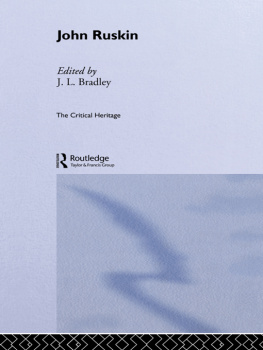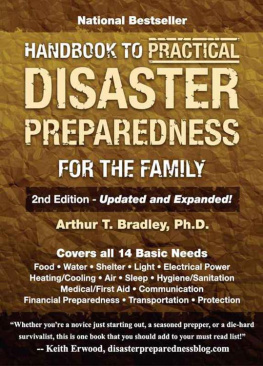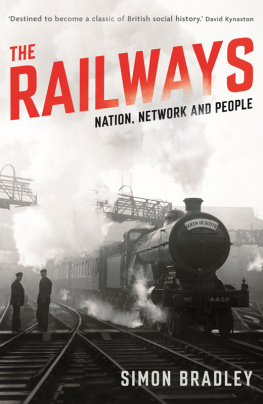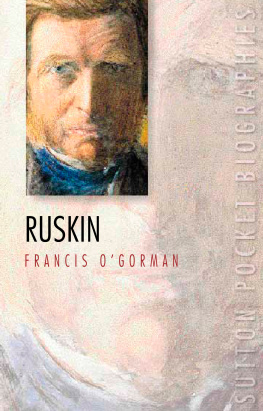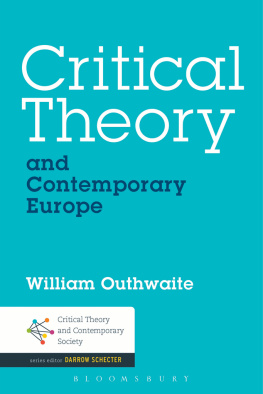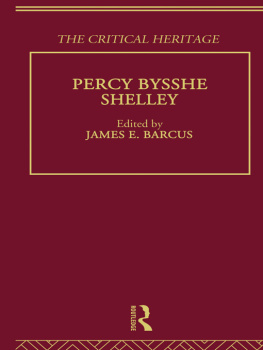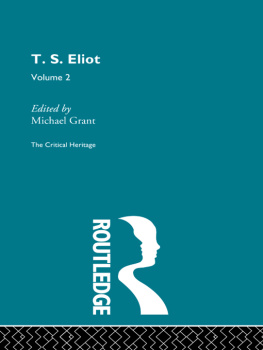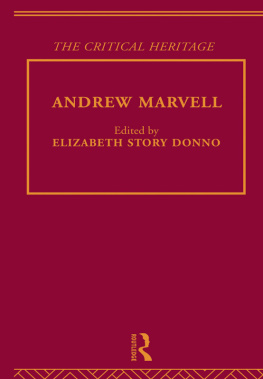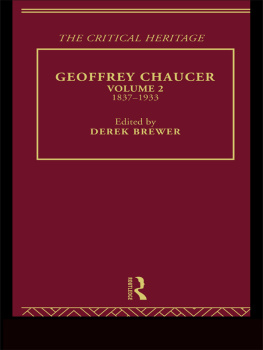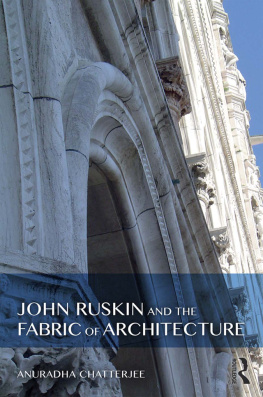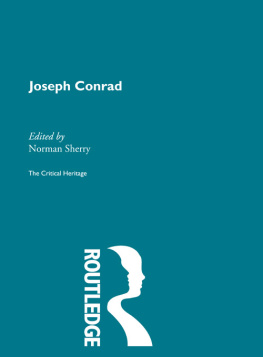| 1819 | John Ruskin born 54 Hunter Street, London (8 February). |
| 1825 | First Continental tour. |
| 1826 | Begins writing verse. Reads Bible, under mothers aegis, continuously, and commences lifelong reading of Homer and Scott. |
| 1830 | First tour of the Lake District. First publication, a poem On Skiddaw and Derwent Water, in the Spiritual Times. |
| 1831 | Attends a school conducted by the Reverend Thomas Dale. Takes drawing lessons. |
| 1832 | Receives gift of Samuel Rogerss Italy, illustrated by Turner. |
| 1834 | First prose work published on the colour of the waters of the Rhine in Loudons Magazine of Natural History. |
| 1835 | Visits Venice for the first time. |
| 1836 | Falls in love with Adele Domecq, daughter of one of his fathers partners in the sherry trade. Writes, but does not publish, a reply to Blackwoods criticism of Turner. Matriculates as a gentleman-commoner at Christ Church, Oxford. |
| 18371838 |  | Publishes The Poetry of Architecture in the Architectural Magazine. |
| 1839 | Wins Newdigate Prize for poetry. Meets Wordsworth. |
| 1840 | Receives, on twenty-first birthday, a private income of 200 per annum and Turners Winchelsea. Leaves Oxford due to illness. In Rome meets Georgiana Tollemache (later Lady Mount-Temple), his main confidante over his love for Rose La Touche. |
| 1841 | Writes King of the Golden River for Euphemia (Effie) Chalmers Gray whom he later marries. |
| 1842 | Receives double fourth at Oxford |
| 1843 | Publishes Modern Painters I. |
| 1846 | Publishes Modern Painters II. |
| 1847 | Experiences an unreturned affection for Charlotte Lockhart, daughter of Scotts biographer. |
| 1848 | On 10 April marries Effie Gray. |
| 1849 | Publishes The Seven Lamps of Architecture. |
| 1850 | Publishes his collected poems. |
| 1851 | Publishes The Stones of Venice I, Pre-Raphaelitism and Notes on the Construction of Sheepfolds. Meets the young Millais. Friendship with Carlyle ripens. Turner dies in December. |
| 1853 | Publishes The Stones of Venice II, III. Summer holiday in Scotland with Effie, Millais and latters brother. Lectures in Edinburgh. |
| 1854 | Annulment of his marriage to Effie who subsequently marries Millais. Defends Pre-Raphaelites in letters to The Times. Teaches at Working Mens College. Develops friendship with Dante Gabriel Rossetti and at about this time makes acquaintance of his brother, William Michael Rossetti, as well. |
| 1855 | Initiates Academy Notes. Meets Tennyson. |
| 1856 | Publishes Modern Painters, III, IV, and The Harbours of England, a commentary on marine drawings which were produced by Turner and Thomas Lupton the engraver. Meets Charles Eliot Norton. |
| 1857 | Publishes The Elements of Drawing (addressed to My dear Reader) and The Political Economy of Art (lectures). Over the next twenty years is to lecture a great deal. |
| 1858 | Agrees to give drawing lessons to Rose and Emily La Touche. Spiritual crisis in Turin. |
| 1859 | Publishes The Elements of Perspective and The Two Paths, the latter a series of lectures. Visits Miss Bells school at Winnington for the first time. |
| 1860 | Publishes Modern Painters V. Unto this Last serialized in Cornhill Magazine (August November). |
| 1862 | Publishes Essays on Political Economy in Frasers Magazine (June 1862 April 1863): publication suspended. Revised, the essays appear in 1872 as Munera Pulveris. |
| 1864 | Death of his father, John James Ruskin. Delivers more lectures including Traffic and Of Kings Treasuries. |
| 1865 | Publishes Sesame and Lilies (lectures). |
| 1866 | Publishes The Crown of Wild Olive (lectures); also The Ethics of the Dust, a series of dialogues originating in Winnington. Emotionally distraught over his relations with Rose La Touche. |
| 1867 | Publishes Time and Tide, by Weare and Tynef, an Epistolary series devoted to social questions. Experiences giddiness and slightly impaired vision. |
| 1868 | A time of extreme emotional difficulty in regard to Rose La Touche. |
| 1869 | Publishes The Queen of the Air. |
| 1870 | Delivers, in February, his inaugural lecture at Oxford, as first Slade Professor of Fine Art, which address forms part of the Lectures on Art offered in the Hilary Term. |
| 1871 | Begins, in January, the epistolary series, Fors Clavigera, which appear monthly until 1878 and intermittently thereafter. Seriously ill at Matlock. Purchases Brantwood in the Lake District. Develops interest in the St Georges Fund for social amelioration. Margaret Ruskin, his mother, dies aged 90. |
| 1872 | Publishes two series of Oxford lectures: Aratra Penetelici (on sculpture) and The Eagles Nest (on science and art). |
| 1873 | Delivers some ornithological lectures, mainly at Oxford, which are ultimately published as Loves Meinie. Ten further lectures, on Tuscan art, later appear as Val d Arno. |
| 1874 | Modification of his spiritual views. |
| 1875 | Begins part-publication of Mornings in Florence. Initiates Proserpine, a botanical series. Also commences part-publication of the geological lectures to become Deucalion. Dabbles in spiritualism. Death of Rose La Touche, aged 27. |
| 1877 | Whistler v. Ruskin case, with latter too ill to attend. Various treatises on art and drawing published. Suffers from giddiness. |
| 1878 | Guild of St George legally constituted. Attacked by serious mental illness. |
| 1879 | Resigns Slade professorship. |
| 1880 | Publishes Fiction, Fair and Foul in 19th Century Magazine; also Arrows of the Chace (miscellaneous correspondence) and the initial part of The Bible |
| 18811882 |  | Further attacks of mental illness. |
| 1883 | Re-elected to Slade professorship and delivers lectures which become The Art of England (1884). Notes his brains are always on the over-boil. |
| 1884 | Delivers The Storm-Cloud of the 19th Century, one of his most exquisitely wrought and self-revealing lectures. Publishes Oxford lectures entitled The Pleasures of England. Increasing mental turmoil. |
| 1885 | Commences his last work of greatness, the auto-biography Praeterita which runs intermittently in parts until July 1889. Mental attacks once more, |
| 1887 | Struggles, after yet further mental onslaughts, to work. Hortus Inclusus (letters) published. |
| 1888 | Makes final Continental journey from which he is brought home by his cousin, Joan Severn, very seriously disturbed. The rest is silence. |
| 1900 | Dies 20 January and is buried in Coniston churchyard. |

